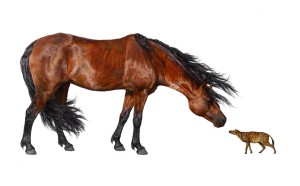Podcast: Play in new window
BOB HIRSHON (host):
Cat-sized horses….I’m Bob Hirshon, and this is Science Update.
Horses originated in North America, but 56 million years ago, they looked a lot different than they do today.
RUSS SECORD (University of Nebraska, Lincoln):
When they first show up, they’re around 12 pounds or so in size.
HIRSHON:
That’s University of Nebraska, Lincoln paleontologist Russ Secord. He says over the next 130,000 years, these mini-horses, called Sifrhippus shrank even more.
SECORD:
Going down to the size of a housecat, which would be around 8 1/2 pounds.
HIRSHON:
He says the horses’ dramatic reduction in body size closely parallels a major period of warming in earth’s history. He says having a smaller surface area would have allowed the horses to shed heat more easily. But he adds that high carbon dioxide levels at the time probably decreased the nutritional content of leaves, which also would have given smaller horses an advantage. When it began to cool down again, the horses grew even larger than they were before. I’m Bob Hirshon, for AAAS, the science society.

